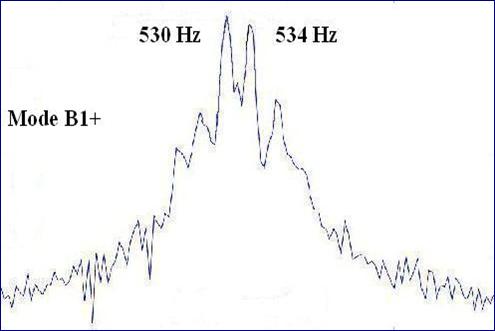
|
Violin wolf note |
|
Copyright © 2010 - 2019 Patrick Kreit. Reproduction of any content of this site without my express written permission is prohibited. |
|
The “wolf note” may be heard on all instruments of the string quartet. Many violins by Stradivari and Guarneri reputedly have it. It is almost the prerogative of powerful violins. Nevertheless, this defect can sometimes be an inconvenience for soloists.
|

|
It is a beat-type self-oscillating frequency, reminiscent of a wolf’s howl that originates in the interaction between the movements of the string and body of the instrument.
Empirical solutions neutralizing the phenomenon do not reveal its true nature. The wolf note is located in the antinodal vibrational region of the top plate’s B1- mode frequency.
FFT real-time analysis software enables you to determine the origin
A fingerboard torsional frequency approaching the B1+ mode frequency can trigger the phenomenon. A bass bar that is too weak behind the bridge will produce the same effect (valid for violins, violas, cellos, and double bass).
The blue zones indicate less amplitude with thicker wood.
For a given frequency, the greater the Q quality factor, the more intrusive the wolf note. It is difficult to produce the same phenomenon on low-quality instruments.
|


|
Two frequency peaks are clearly visible (split) with a delta of 4 Hz the origin of the wolf tone’s beat.
When a string’s frequency is close to |
|
On the violin, the wolf note is nearly always in the frequency range of the B1+ mode: B4 to C#5
The B1+ mode frequency contributes to the wolf note’s action but is not the cause of the split on this frequency.
For the wolf note to be heard, there must first be a defect in top plate or bass bar thicknesses . A single instrument can present both of these problems.
This is a complex phenomenon, for several causes may exist that set the string rolling under
At least two conditions must be met to cause a split on the B1+ mode frequency.
The bow catches the string, releases it, then grabs it again and lets it go, approximately 7 to 10 times per second. These vibratory interferences provoke phase oppositions at the level of sound emission. This phenomenon can be reduced, but never completely eliminated, due to its origin in
To remedy this problem, mass must be added, either at the end of a string (behind the bridge),
The wolf note can be activated by an instrument’s variable body frequency, in direct relation Moisture content in the materials modifies all of the body frequencies, as well as the shape
The delta between modes B1- and B1+ will be modified if moisture content is not identical
A wolf note eliminator installed on a string requires precise adjustment. Its weight and position must be verified in order to avoid a loss of tone in the instrument. It imposes a direction
A wolf note eliminator glued on the intrados of the top plate or on the bar yields good results Magnetic wolf suppressors have an advantage over classical ones: they can be moved about
A wolf suppressor is a remedy, but still is not the solution to the problem.
The wolf note is most often heard on:
¨ violin: B to C# on the A-string;
¨ viola and cello: E to F# on the C- or G- or D-string;
¨ double bass: G# on the D-string. |